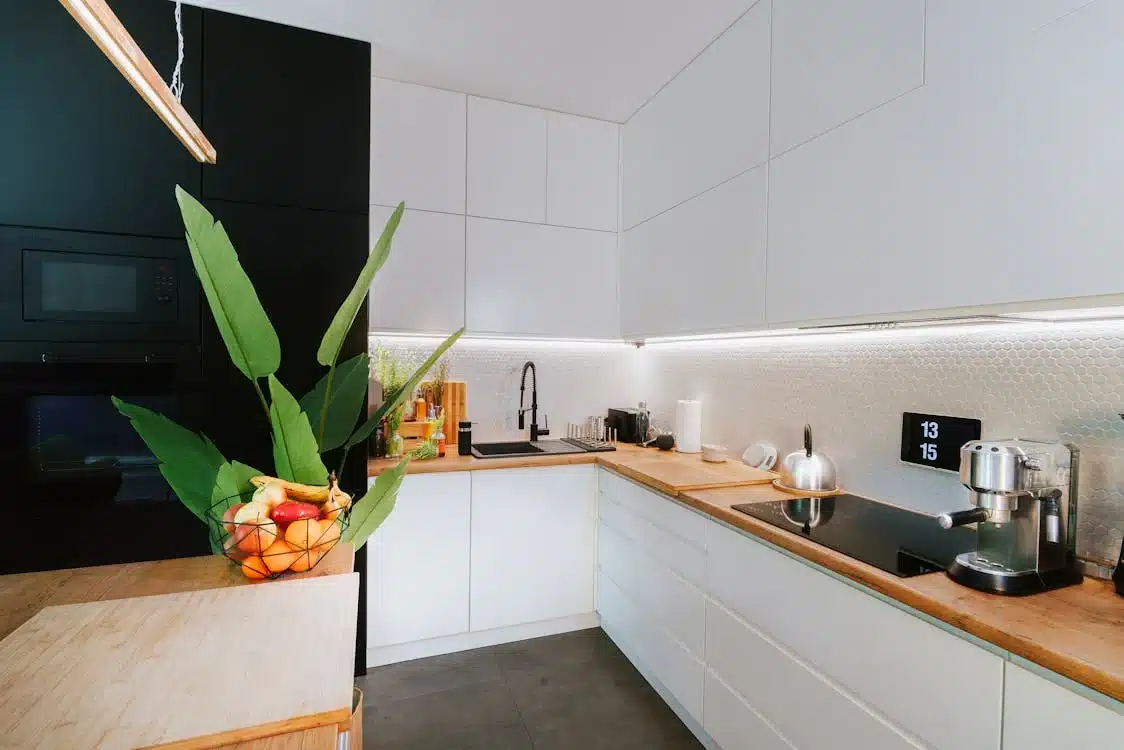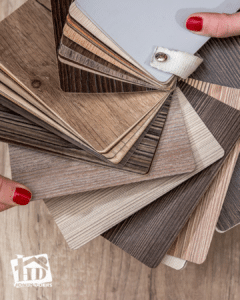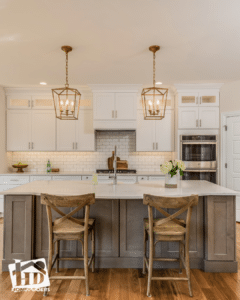Smart home design is an art, and it is revolutionizing the way we live, blending convenience, security, and energy efficiency into our daily routines. Once considered futuristic, smart devices have now become essential in modern home design, offering homeowners greater control over their environments while seamlessly integrating into interior aesthetics.
From app-controlled lighting to automated climate control, today’s smart home features are designed to enhance both functionality and style. These innovations not only improve comfort but also contribute to a sleek, uncluttered home by eliminating the need for bulky switches, remotes, and manual adjustments.
By thoughtfully incorporating smart home interior design, homeowners can create a space that is both visually appealing and highly efficient. Whether you’re planning a full remodel or simply looking to upgrade your living space, integrating smart technology into your home design ensures a modern, future-ready home.
Let’s explore some of the best ways to seamlessly blend technology and interior design for a smarter, more stylish home.
How Smart Home Tech Integrates with Interior Design
A well-designed smart home seamlessly incorporates technology into its interior without disrupting aesthetics. Rather than competing with décor, smart technology should complement and enhance the existing design of a home. The goal is to create an environment where convenience meets sophistication, blending cutting-edge automation with thoughtfully curated interior elements.
Ways Smart Home Technology Enhances Interior Design
- Minimalist Look: By eliminating the need for visible switches, thermostats, and cords, smart home technology contributes to a cleaner, more streamlined space. Touchless controls, voice-activated systems, and centralized management reduce visual clutter and allow for a sleek, modern aesthetic.
- Seamless Automation: Smart lighting, climate control, and entertainment systems integrate effortlessly into a home’s design, offering bothhttps://www.honey-doers.com/interior-design/8-ways-smart-lighting-can-make-your-home-feel-more-spacious/ convenience and a high-tech appeal. Automated settings adjust the environment based on the time of day, personal preferences, or occupancy.
- Customizable Ambiance: Smart features allow homeowners to set the perfect mood in any room. Whether adjusting lighting intensity and color, playing background music, or setting a cozy temperature, smart technology enhances the sensory experience of home life while remaining discreet.
Actionable Tips for Integrating Smart Tech into Interior Design
- Match Finishes & Styles: Choose smart home devices in finishes that coordinate with your décor, such as matte black, brushed nickel, or wood accents.
- Opt for Hidden Installations: Built-in speakers, recessed lighting, and under-cabinet LED strips offer high functionality without compromising style.
- Enhance Atmosphere with Smart Features: Use dimmable smart lighting, automated blinds, or synchronized sound systems to create the ideal ambiance for any occasion.
By thoughtfully integrating smart home interior design, homeowners can enjoy both advanced functionality and a beautifully cohesive living space.
Smart Home Tech That Blends with Interior Design
Technology and aesthetics don’t have to be at odds. With thoughtful interior design, smart home tech can seamlessly integrate into your home’s interior, adding both function and style. Below are some of the most impactful smart home features that can enhance your living space while maintaining a cohesive, visually appealing design.
Smart Lighting: Elevating Function and Ambience
Lighting is one of the most transformative elements in smart home interior design. With the ability to change brightness, color, and scheduling, smart lighting allows homeowners to tailor the ambiance of their home to match their mood, time of day, or specific activities.
Integration Ideas:
- App-Controlled or Voice-Activated Lights – Adjust brightness and color temperature through smart assistants like Alexa, Google Home, or Apple HomeKit for effortless customization.
- Color-Changing LED Lights – Set different moods for relaxation, focus, or entertaining with tunable white or RGB smart bulbs.
- Motion-Sensor Lighting – Enhance convenience and energy efficiency by illuminating pathways and rooms only when needed.
Design Considerations:
- Recessed or Track Lighting – For a sleek, modern look, install smart recessed lights that blend into ceilings while offering full automation.
- Under-Cabinet LED Strips – Add task lighting in kitchens or workspaces that can change warmth levels based on the time of day.
By incorporating smart lighting into your home design, you enhance both functionality and aesthetics, making each space feel dynamic and adaptable.
Smart Climate Control: Comfort Meets Aesthetics
A comfortable home is essential, but bulky thermostats and temperature controls can disrupt a clean, minimalist interior. Fortunately, smart climate control systems provide discreet yet powerful solutions for maintaining the perfect indoor environment.
Integration Ideas:
- Smart Thermostats (Nest, Ecobee, Honeywell) – These devices learn your habits and adjust temperatures automatically to optimize comfort and energy savings.
- App-Controlled Fans and Blinds – Automated window treatments and ceiling fans adjust based on temperature, time of day, or sunlight levels, reducing the need for manual intervention.
Design Considerations:
- Wall-Mounted Thermostats with Minimalist Designs – Opt for sleek, touchscreen displays that blend into your home’s aesthetic rather than clunky, outdated thermostats.
- Hidden Vent Systems – Modern smart vents distribute air efficiently while maintaining a streamlined appearance in walls, ceilings, or floors.
With smart home climate control, your home stays comfortable year-round without sacrificing style.
Smart Energy Management: Efficiency and Design
Reducing energy waste doesn’t mean cluttering your home with wires, switches, and meters. Smart energy management systems integrate seamlessly into a home’s design while improving sustainability and efficiency.
Integration Ideas:
- Smart Plugs and Power Strips – These allow you to control energy usage remotely, turning off devices when they’re not in use.
- Automated Blinds – Smart window treatments can adjust based on time of day, optimizing natural light and reducing the need for artificial lighting and heating/cooling.
Design Considerations:
- Hidden Energy Control Panels – Instead of placing controls in plain sight, tuck them into closets or inside cabinets to maintain a clutter-free aesthetic.
- Stylish Solar Panel Integrations – Modern solar panels come in sleek designs that can complement the home’s exterior rather than looking like an afterthought.
A well-designed smart home energy system not only saves money but also blends effortlessly into the home’s architecture.
Smart Home Security and Maintenance: Protection Without Disrupting Aesthetics
Security is a priority for any homeowner, but traditional cameras, alarms, and locks often stand out in a way that clashes with carefully curated interior design. Modern smart home security systems offer both discretion and protection.
Integration Ideas:
- Smart Doorbells with Cameras – Devices like Ring or Nest Hello allow homeowners to monitor visitors without installing large, obtrusive security cameras.
- Discreet Motion Detectors and Security Cameras – Compact, wireless designs allow for easy placement in hidden areas like bookshelves, ceilings, or outdoor fixtures.
- Smart Leak Detectors and Water Shutoff Systems – These devices prevent costly damage by detecting leaks early and shutting off water automatically, all while remaining out of sight.
Design Considerations:
- Neutral-Colored Security Cameras – Choose models that match your home’s walls, ceiling, or trim to make them less noticeable.
- Recessed Wall Safes – Instead of bulky safes, opt for hidden storage solutions that blend into existing cabinets or walls.
With smart home security solutions, homeowners can protect their property without disrupting their interior aesthetics.
Incorporating smart home technology into your interior design doesn’t mean sacrificing style. By selecting the right devices and considering their placement, you can enjoy the benefits of a high-tech home while maintaining a cohesive and visually appealing space. Up next, we’ll explore the best design practices for ensuring that your smart home technology remains unobtrusive and future-ready.
Designing with Smart Home Tech in Mind
Successfully integrating smart home technology into your home’s interior design requires thoughtful planning. Instead of adding tech as an afterthought, consider how each device will fit into your overall aesthetic from the beginning. Below are some key design principles to ensure your smart home interior design is both functional and visually appealing.
Design with Your Smart Home in Mind
When building or renovating your home, it’s important to think about smart home design from the outset. Integrating smart technology into your plans ensures that it enhances rather than disrupts your home’s aesthetic.
Tips:
- Look at Examples of Other Smart Homes: Gain inspiration by exploring real-life smart home setups through design magazines, websites, or model homes.
- Work with Designers & Builders: Collaborate with professionals who specialize in integrating technology into interior design for a seamless, stylish result.
- Consider Wiring and Infrastructure: Smart devices need proper placement for power and connectivity—planning this in advance avoids visible wires or awkward installations.
By designing with smart home technology in mind, you can ensure it complements your space rather than feeling like an add-on.
Hide the Controls
A major challenge in smart home design is keeping controls sleek and unobtrusive. While smart home systems improve convenience, large panels and multiple remotes can clutter walls and surfaces. The key is to make controls blend into your home’s design.
Tips:
- Use Built-in Wall Panels: Opt for recessed touchscreens or in-wall control panels that lie flush with the surface.
- Opt for Voice-Activated or App-Based Controls: Devices like Amazon Alexa, Google Assistant, and Apple HomeKit reduce the need for visible switches or remotes.
- Conceal Smart Switches: Install switches behind furniture, under cabinets, or use decorative covers that match your wall finish.
Minimizing visible controls keeps your smart home interior design modern and clutter-free.
Blend In
Smart home devices don’t have to stand out. Choosing designs that match your existing décor will help maintain a cohesive, stylish look.
Tips:
- Match Finishes to Existing Hardware: If your home features brushed nickel, matte black, or brass accents, choose smart devices in similar finishes for a unified appearance.
- Choose Sleek, Minimalist Designs: Many smart home gadgets come in neutral colors and streamlined shapes—opt for those that complement your home’s aesthetics.
- Consider Hidden or Built-in Solutions: Smart speakers, security cameras, and even TVs can be recessed into walls, ceilings, or custom cabinetry for a seamless look.
With the right approach, smart home interior design enhances your home’s aesthetic without clashing with it.
Future-Proof It
Technology evolves quickly, and your smart home design should be able to adapt to new advancements. Future-proofing ensures that your home remains compatible with the latest tech and doesn’t become outdated.
Tips:
- Use Modular Systems: Invest in technology that allows for easy upgrades or expansions, such as modular smart lighting and expandable security systems.
- Invest in Cross-Compatible Devices: Choose smart home products that work across multiple platforms (Google, Apple, Amazon) to avoid being locked into one ecosystem.
- Plan for Extra Connectivity: Make sure your home has enough Ethernet ports, strong Wi-Fi coverage, and extra power outlets in key areas for future smart devices.
A future-proofed smart home keeps your investment relevant and functional for years to come.
Have a Hidden Central Control Center
A smart home works best when all devices are connected to a central system, but that doesn’t mean the hub should be in plain sight. Keeping control systems tucked away maintains a clean, modern aesthetic while ensuring functionality.
Tips:
- Dedicate a Hidden Area for Smart Tech: Store routers, hubs, and control systems in a closet, utility room, or discreet cabinet to keep them out of sight.
- Use a Centralized Smart Home App: Reduce the need for multiple control panels by managing everything from one intuitive app.
- Integrate Power & Ventilation: If storing tech in a closet, ensure there’s adequate airflow and power sources for optimal performance.
A hidden central control center ensures a seamless smart home design without visual distractions.
By incorporating these smart home interior design strategies, homeowners can create a living space that is both high-tech and beautifully designed. Up next, let’s explore why working with experienced professionals is the best way to achieve a seamless, stylish smart home.
Consult a Designer with Experience
Successfully integrating smart home technology into your interior design requires a balance between functionality and aesthetics. While DIY solutions can be tempting, working with an experienced professional ensures that your smart home design is seamless, future-proofed, and visually cohesive.
At Honey-Doers Remodeling, we specialize in smart home integration, helping homeowners create stylish, high-tech living spaces tailored to their needs. Whether you’re looking to enhance your home with smart lighting, automated climate control, security systems, or energy-efficient solutions, our team ensures a flawless installation that complements your design vision.
From new builds to renovations, we work closely with you to develop a customized smart home system that blends cutting-edge technology with timeless design. Our expertise guarantees that your home remains both modern and adaptable to future advancements.
Ready to upgrade your home with smart technology? Contact Honey-Doers Remodeling today to explore how we can bring smart home interior design to life in your space!






